
経営における矛盾を両立するパラダイムは何か?
このnoteに興味をもって頂き、どうもありがとうございます。このノートでは、私がこれまでの社会人生活の中で、探求し続けてきた最も根源的な問いについて共有させて頂きたいと思います。
私自身の人生ストーリーは、別の記事にて紹介させていただくとして、ここでは簡単な略歴のみご紹介します。私は、大学まで物理学を勉強して、新卒でボストンコンサルティンググループ(以下、BCG)に入社しました。その後、2003年に社会人教育を手がけるアルー株式会社を起業して、2018年にマザーズ上場。今に至ります。
経営とは矛盾の両立
物理→BCG→起業→上場というプロセスを経験してきた私にとって、「経営とは矛盾の両立」です。経営に携わっていると、様々な矛盾やギャップに直面します。自分がやりたいことと周囲がやりたいことのギャップがでてきたり、理想を追い求めることと現実のビジネスを回すことの両立ができなかったり、顧客からの要求と、その要望に対応できるリソースの質や量にギャップがあったり、矛盾に直面しない日はないと言っても過言ではありません。
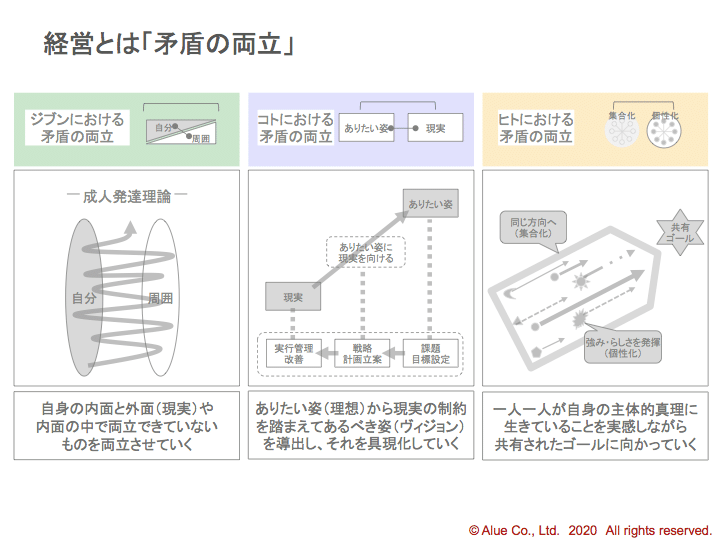
この図表では、経営における矛盾を3つにカテゴリ化しています。1つ目は、ジブン領域であり、自分の内面と、自分の外面となる周囲の人々やビジネスの現実との間の矛盾です。例えば、自分がやりたいことと、周囲の人々がやりたいことのギャップなどが挙げられます。
2つ目は、コト領域であり、ありたい姿と現実のギャップです。ヴィジョンと現状のギャップであったり、目標と実績のギャップであったり、顧客からのクレームであったりします。
3つ目は、ヒト領域であり、ひとり一人の個性を大切にするという多様性・個性性の考え方と、ワンチームとして一致団結することを大切にする集団性の考え方の間の葛藤です。ひとり一人の価値観や個性を大切にする最近の世の中の流れは誰もが感じているところだと思います。一方で、組織として力を発揮するためには、チームとして力を結集する必要もあります。ヒトの領域においては、個性性と集合性が2つの極となり、常にその間のテンションが存在します。(この2つは、必ずしも対立するという話ではなく、両立することも可能です)
このようなギャップに対峙しながら、その矛盾を何とか両立する、解決することによって、うまくやっていくのが経営であり、マネジメントであると思います。
両立の本質は止揚(アウフヘーベン)の世界観
ここまで、経営とは矛盾の両立であるという話をしてきましたが、「両立」という言葉が意味するところを深掘りしたいと思います。
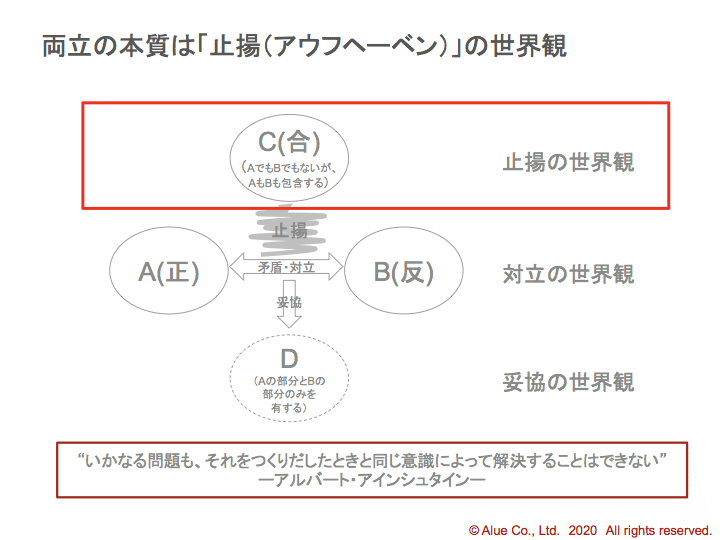
この図に表現されている通り、両立の本質は止揚(アウフヘーベン)の世界観です。止揚とは、ドイツの哲学者ヘーゲルが提唱した概念で、AとBが矛盾・対立しているときに、AでもBでもないが、AもBも包含するような解を導くことを指します。
例えば、製造業において、「品質を高めるべき」という意見(A)と、「コストを削減するべき」という意見(B)があったときに、普通の感覚では品質を高めるためには新しい設備や研究開発が必要となりコスト増になりますし、コストを削減しようと思うと、これまで価値提供していた何かを削らなければいけないように思えます。
このときに、(いくつもある選択肢のうちの1つの例ですが)、「商品点数を絞り込むことよって、いまある研究開発リソースを集約して品質の向上を図りながら、生産効率を高めてコストを削減する」というアイディア(C)があるかもしれません。
このアイディア(C)は、もともとの(A)や(B)とは違う内容ですが、(A)と(B)の内容を包含しています。このように、矛盾・対立する2つ以上の要素を包含して、統合するような高次の解決策を導くのが止揚の世界観となります。
ところで、物理学というのは、一言で言えば、森羅万象を統合していく学問と言えます。物理学に携わる人は、一見異なる事象を、1つの方程式で説明する動機を持っています。例えば、りんごが木から落ちるという現象と、月が地球の周りをまわるという一見異なる現象を、万有引力の法則という1つの方程式で説明しようとします。
私と物理の出会いについては別の記事でご紹介するとして、私は物理学の「森羅万象を統合していく」という美しさに惹かれて、大学院に至るまで学んできました。その私にとって、経営における様々な矛盾に対峙したときに、どうしたら一見矛盾する要素を両立することができるのか、統合することができるのか、を考えることは自然な成り行きでした。
そして、コンサルティング会社でクライアントの経営に関わる経験と、起業をしてビジネスを創り出していく起業家としての経験を通じて、経営における様々な矛盾とその両立・止揚のプロセスを体感していくなかで、もう一段メタ的な観点からの問いが湧き上がります。
それは「経営における(さまざまな)矛盾を両立する(統合的な)パラダイムは何か?」ということです。
突き詰めていくと、「意識」にたどり着いた
この問いに対して、社会人になってから、そして、起業してから向き合い続けたと言っても過言ではありません。詳細な経緯は、別の記事にてご紹介しますが、特にこの1年間は同じ志の仲間と共に、この問いに対する1000時間以上の研究開発活動をしてきました。そして、たどり着いた答えは、とても身近にあるものだったのです。
それは、「意識」です。最初の問いに答えるならば、経営における矛盾を両立するパラダイムは「意識の意識化」です。
「経営と意識って、何の関係があるの?」と疑問に思われる方が多いのではないでしょうか?これから、経営というマクロな視点の取り組みと、意識というミクロな視点のあり方が、どのように繋がるのかをご説明します。
経営には、売上・コスト・利益という財務的な結果や、戦略やオペレーション、組織開発や人材育成の取り組みなど、様々な側面があります。
売上・コスト・利益などの財務的な結果(現象面の結果)は、戦略やオペレーションや組織のあり方などの自社にとっての戦略変数が、顧客のニーズや競争環境などと相互作用した結果として、現れているものです。
すなわち、現象面の結果(財務結果など)←現象面の構造や背景(顧客ニーズや競争環境、自社の戦略変数)という構図になっています。
そして、自社にとっての戦略変数の元には、1人1人の行動があり、その行動の元には決断があり、決断の元には思考や感情があり、思考や感情の元にはメンタルモデル(信念体系)があり、メンタルモデルの元には主体的真理(詳しくは別の記事にて)があり、その元には自己(自意識の主体)があります。
現象
↓
現象の構造・背景
↓
行動
↓
決断
↓
思考・感情
↓
メンタルモデル(信念体系)
↓
直感(主体的真理)
↓
自己(自意識の主体)
そして、この図において「決断」から「自己」にいたるまで、全て「意識」に関わっていると言えます。意識は、現象の根源なのです。
「意識の意識化」というのは、この「決断」から「自己」に至るまでの要素を、本当の自分のありたい姿に近づくようにマネジメントするということです。逆に言えば、「意識の意識化」をすることで、行動が変わり、現象の構造や背景が変わり、現象の結果が変わっていくのです。
意識は、我々にとって、非常に身近なものです。この記事を読んでいるあなたは、いまここで意識をこの記事に集中させています。では、なぜ、そのような身近なものである意識を、わざわざ意識化する必要があるのでしょうか?
実は、我々は、意識をコントロールできているようで、できていないことが多いのです。自分が本来意図していない発言や行動をして、人を傷つけてしまったことや、うまくいくはずのものがうまくいかなかったりしたことは、誰しも経験があるのではないでしょうか。逆に、自分が思っていた以上のパフォーマンスを発揮することができたということもあるかもしれません。
自分の意識全てをコントロールすることができるわけではありません。(お釈迦様は別かもしれませんが。。。)しかし、意識を意識化することによって、マネジメントできる範囲を広げていくことはできます。マネジメントできる範囲を広げていくことで、本来の自分のありたい姿に近づいていくと共に、経営としても望ましい結果を生み出していくことができます。
3+1意識モデル
ここまで、経営における矛盾を両立するパラダイムは意識の意識化であるということをお話してきました。そうすると、「どうすれば意識を意識化できるのか?」ということが問いとして浮かんできます。
ここまで、少し長く記事を書いていますが、もう少々お付き合いください。実は、ここからが本番です。この1年間の探求の中で、我々は「意識の意識化」というコンセプトを体現するための「意識モデル」を構築してきました。

これが、3+1意識モデルです。3+1意識モデルには、自己とメタ的自己という「2つの自己」が登場します。そして、自己に属する直感意識・思考意識・身体意識という3つの意識と、メタ的自己に属するメタ意識の「3+1の意識」から構成されます。
3+1意識モデルを意識化すると、どんないいことがあるのでしょうか?
3+1意識モデルの真髄は、1つの記事だけで表現できるものではないので、これから少しずつ説明していきたいと思いますが、本記事においては3つのポイントに絞ってご紹介します。
1つ目は、3+1意識モデルで捉えることにより、特定の意識への偏りを防ぎ、自分の全体を感じやすくなります。現代の社会人は、思考意識に偏りやすいです。思考意識は、言語を扱うことができるため、他者との情報の共有に長けています。ビジネスの世界では特に、説明可能性・共有可能性が重視されますので、思考意識が大切になることは頷けます。
しかしながら、思考意識に偏りすぎると、直感からのメッセージを無視してしまったり、身体意識(不快感情や身体の不調)を軽視してしまうことにつながり、自分としての健全な状態を保てなくなったりします。
2つ目は、メタ意識の感覚をもつことにより、葛藤や困難と向き合いやすくなります。映画のメタファーでいえば、映画に出演している俳優を自己とすれば、映画監督がメタ的自己です。メタ意識は、まさにこの映画監督の目線となります。
私自身、コロナ禍における業績の低迷に苦しみました。今でこそ、自社事業のDX(デジタルトランスフォーメーション)化を推進する最大の機会を得たと前向きに捉えることができていますが、2020年の3月・4月は精神的にかなり苦しい時期が続きました。
そのようなときに、俳優として苦しんでいる自分を見守っている、もう一人の映画監督としての自分を意識することによって、自分の苦しみが少し和らいだのです。「このシーンは、映画全体のストーリーにとって大切な場面だから、苦しい自分を演じきろう」とエールを送ることができたのです。
このように、メタ意識をもつことによって、自分が出演している映画を外から監督目線で見守る感覚を持つことができると、葛藤や困難と向き合いやすくなります。
3つ目は、3+1意識モデルは、体内感覚的にいつでも実践可能な、身近なものであるということです。経営に役立つフレームワークや理論などもたくさんありますが、それらの多くは現象化した事象を扱っているため、個人の体内感覚的に再現できるものではないことが多いです。
因果で大きく分けるならば、フレームワークや理論は因果の「果」を扱っていることが多いため、「では、自分はどうすればいいのか」ということについて腑に落ちないことがあります。(私は、このことを「積分的」であると表現しています)
一方、3+1意識モデルは、因果の「因」を扱います。先ほどもご説明した通り、意識が行動を生み出し、行動が現象を生み出すからです。そして、意識は、体内感覚的に感じることができるものですし、いつでも実践可能な身近なものであることは、先ほど述べた通りです。(私は、このことを「微分的」であると表現しています)
ここまで、意識の意識化を具現化するための「3+1意識モデル」とはどのようなものか、そのメリットは何かについてお話しました。
この話自体は理解できるとしても、最初の「経営」という視点に立ち戻った時に、だいぶ遠い話をしているという印象をもたれた方もいるのではないでしょうか。
矛盾を両立する経営の全体像
3+1意識モデルは、経営における矛盾を両立するためのパラダイムそのものであり、かつ、いつでも誰でも実践可能な形式であるという意味で、最も本質的なものです。
一方で、本質的であるがゆえに、「経営」という視点での全体像と結びつきにくいことも確かです。
私たち探求チームは、3+1意識モデルが「経営における矛盾を両立するためのパラダイム」のミクロ的・微分的な表現であるとしたときに、そのパラダイムの全体像を表すマクロ的・積分的な表現は何かを探求してきました。
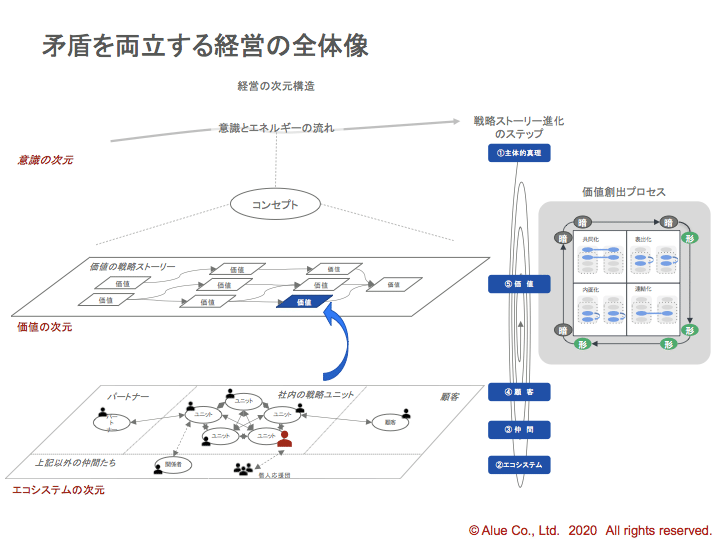
これが、「経営における矛盾を両立するためのパラダイム」のマクロ的な、積分的な全体像です。
この全体像の詳細の全てをここで説明することは、記事の分量的に難しいので、これからの記事に譲るとして、ここでは特徴とメリットを3つほどお話することにとどめたいと思います。
第一の特徴は、この記事の最初に挙げたジブン・ヒト・コトの矛盾を全て包含しているということです。ジブンやヒトの矛盾は、エコシステムの次元において表現されており、コトの矛盾は価値の次元に表現されています。また、ジブン・ヒト・コトそれぞれの領域内での矛盾だけではなく、ジブンとヒトの間の矛盾、ヒトとコトの間の矛盾についても包含しています。
このように、全体像の中に矛盾や葛藤を包含することによって、目の前の問題に対して、AかBのどちらかという対立の世界観ではなく、AもBも包含する新たなCという止揚の世界観を持ちやすくなります。
第二の特徴は、マクロ的・積分的な全体像とミクロ的・微分的な体内感覚をつなげているということです。この図の右側に3+1意識モデルが記載されていることにお気づき頂いている通り、この全体像を創り出す根源となる「意識の意識化」を包含しています。
これによって、自分のどのような体内感覚が、経営全体にどのようなインパクトを与えるのかを繋げて捉えることができます。端的に言えば、「自分の意識」と「会社の売上・利益」のつながりを、直感的・体感覚的に捉えることができます。
自分の意識との繋がりがない中で、この全体像を「実現するべき目標」として捉えるとうまくいかないのです。「ないものをひねり出す」という感覚では実現のエネルギーが枯渇してしまうからです。逆に、自分の内面から湧き出てくるエネルギーを当てる的として、この全体像を世界観として持っておくとうまく回っていきます。
第三の特徴は、この全体像には、経営学やコンサルティングの世界でよく使われるフレームワークや、経営理論を包含しているということです。経営のフレームワークや経営理論に詳しい人は、この全体像を見ただけでも、下記のような理論が含まれていることに気づかれたのではないでしょうか。
▼SECIプロセス・・・「知識創造企業(野中郁次郎、竹内弘高)」
▼ストーリーとしての競争戦略・・・「ストーリーとしての競争戦略(楠木建)」
▼イノベーションのジレンマ/両利きの経営・・・(クレイトン・クリステンセン、チャールズ・オライリー、マイケル・タッシュマン)
▼二重過程理論・・・「ファスト&スロー(ダニエル・カーネマン)」
上記以外にも、ポーターのSCP理論(Structure Conduct Performance Theory)とバーニーのリソースベーストビュー(RBV:Resource Based View)の統合的な考え方や、デザイン思考・アート思考など、イノベーションの文脈で重視されている最近の考え方まで包含しています。
この記事で提唱しているモデルや全体像は、既存の経営理論を否定するものではありません。むしろ両立して、相互補完できるものと考えています。
これらの経営理論と両立していることがなぜ大切と考えているかと言えば、客観的に検証されている経営理論と概念や言語を接続することによって、このコンセプトやモデルの有効性の検証をすることができるからです。
現時点においては、3+1意識モデルや、矛盾を両立する経営の全体像は、学術的に検証されたものではなく、仮説に過ぎません。ただ、現段階から、検証されている経営理論との概念接続をすることによって、将来的な検証や反証可能性を担保して、このモデルが進化していく環境を整えたいという思いがあります。
この記事では、経営における矛盾を両立するパラダイムは「意識の意識化」であること、その具体的なモデルや考えかとして、ミクロ的・微分的な「3+1意識モデル」と、マクロ的・積分的な「矛盾を両立する経営の全体像」をご紹介してきました。
この記事を読んで、少しでも面白い、役に立ちそう、活用してみたい、と思われた方々に向けて、今後の記事において、これらの世界観を、より詳しく共有したいと考えていますので、お楽しみに!
長文、お読みいただき、どうもありがとうございました。
落合 文四郎
What is the paradigm for integrating contradictions in management?
Thank you for your interest in this note. In this note, I would like to share the most fundamental questions that I have been exploring throughout my working life.
My own life story will be presented in another article, but I will only provide a brief biography here. I studied physics through graduate university and joined the Boston Consulting Group ("BCG") as a fresh graduate. Then in 2003, I started Alue Corporation, an adult education company, and listed it on Mothers Market in 2018.
Management is an integration of contradictions
Having experienced the process of physics, BCG, entrepreneurship, and public listing, for me, management is an integration of contradictions. When you are involved in management, you are confronted with many contradictions and gaps. There is a gap between what you want to do and what the people around you want to do, an inability to reconcile the pursuit of ideals with the realities of running a business, a gap in the quality and quantity of resources available to meet customer demands, and it is no exaggeration to say that not a day goes by when I am faced with contradictions.
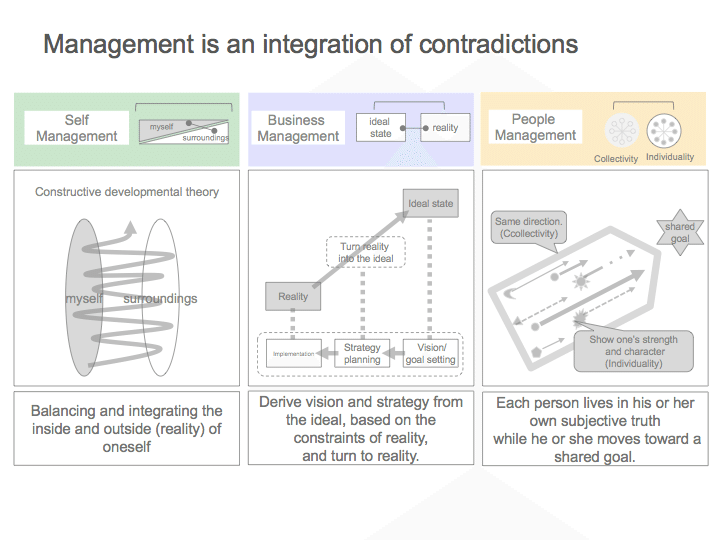
This figure breaks down management contradictions into three categories: the first is self management area, the contradiction between self and the surroundings and business reality around the self. For example, the gap between what we want to do and what the people around us want to do.
The second is business management area, the gap between what we want to be and reality. This can be the gap between vision and reality, the gap between goals and performance, or customer complaints.
The third area is people management area, which is the conflict between the idea of diversity and individuality, where the individuality of each person is valued, and the idea of collectivity, where it is important to work together as a team.
I think we all feel the recent trend in the world to value each person's values and individuality. On the other hand, in order to be powerful as an organization, we also need to work together as a team. In the people management area, individuality and collectivity are the two poles, and there is always a tension between them. (I'm not necessarily talking about the two being at odds; they can go together.)
It is management that confronts these gaps, but manages to make it work by balancing and integrating these contradictions.
The essence of balancing and integrating is the worldview of Aufheben
Now that we've talked about how management is the balancing and integrating of contradictions, I'd like to dig deeper into what is meant by the word "balancing and integrating."
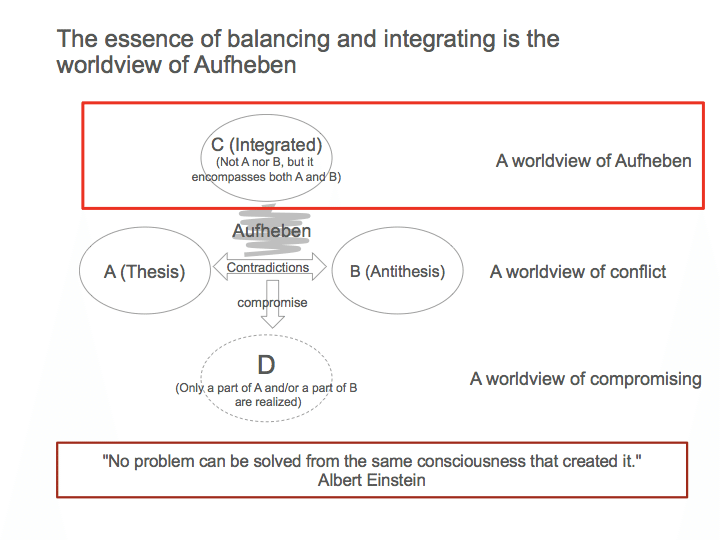
As expressed in this figure, the essence of "balancing and integrating" is the worldview of Aufheben. This concept, proposed by the German philosopher, Georg Wilhelm Friedrich Hegel, refers to a solution that is neither A nor B, but includes both A and B, when A and B are in conflict or contradiction.
For example, in the manufacturing industry, when there is an opinion that "quality should be improved" (A) and an opinion that "costs should be reduced" (B), in the ordinary sense, in order to improve quality, new equipment and research and development will be required, which will increase costs, and if you want to reduce costs, it seems that you will have to cut something that has been providing value in the past.
At this point, you might have idea (C), which may one example of many options, that by narrowing down the number of products, you can consolidate your existing R&D resources to improve quality while increasing production efficiency and reducing costs.
This idea (C) is different from the original (A) and (B), but it encompasses the essence of (A) and (B). Thus, the worldview of Aufheben leads to a higher-order solution that encompasses and integrates two or more contradictory and opposing elements.
By the way, physics, in a nutshell, can be said to be the study of the integration of all the elements of the universe. People involved in physics have a motivation to explain seemingly different events with a single equation. For example, they try to explain the phenomenon of an apple falling from a tree and the apparently different phenomenon of the moon orbiting the earth with one equation, the law of universal gravitation.
I'll discuss my encounter with physics in another post, but I was drawn to the beauty of physics' "integration of all the elements of the universe," which is what I studied all the way through graduate school. For me, when confronted with the various contradictions in management, it was a natural progression to think about how to integrate the seemingly contradictory elements.
Through my experience as a consultant at BCG and as an entrepreneur, I experienced the various contradictions in management and the process of balancing and integrating them, which led me to ask a question from a more meta perspective.
What is the (integrative) paradigm that integrates (various) contradictions in management?
When I went deeper and deeper, I got to "consciousness"
It's not an exaggeration to say that I have been facing this question since I started to work at BCG and since I started my own business. I'll share the details in another article, but especially in the past year, I've spent more than 1,000 hours in research and development on this question with like-minded colleagues. And the answer we arrived at was something very close to our daily things.
It is consciousness. To answer the first question, the paradigm that integrates the contradictions in management is "ISHIKI(Consciousness) Management".
What does management and consciousness have to do with each other? Many of you may be wondering. I will now explain how the macro perspective of management and the micro perspective of consciousness can be connected.
There are many aspects of management, including financial results in terms of sales, costs and profits, as well as initiatives such as strategy, operations, organizational development and human resource development.
Financial results (phenomenal results) such as sales, costs, and profits are the result of the interaction of strategic variables for the company, such as strategy, operations, and organizational structure, with customer needs and the competitive environment.
In other words, the result of the phenomenon (e.g., financial results) comes from the structure and background of the phenomenon (customer needs, competitive environment, and the company's strategic variables).
And, for the company, the strategic variables are based on the actions of each individual, the actions are based on decisions, the decisions are based on thoughts and emotions, the thoughts and emotions are based on mental models (belief systems), the mental models are based on subjective truths (more on that in another article), and the subjective truths are based on self (the subject of self-consciousness.)
Phenomenon
↓
Structure and background of the phenomenon
↓
Behavior
↓
Decision
↓
Thoughts and feelings
↓
Mental models (Belief systems)
↓
Intuition (Subjective truth)
↓
Self (The subject of self-consciousness)
And in this figure we can say that everything from "Decision" to "Self" is related to "consciousness". Consciousness is the source of phenomena.
"ISHIKI(Consciousness) Management" means to manage these elements from Decision to Self in such a way that they bring you closer to what you really want to be. In other words, by "ISHIKI(Consciousness) Management", our behavior changes, the structure and background of the phenomenon changes, and the outcome of the phenomenon changes.
Consciousness is something we are very familiar with. If you are reading this article, you are focusing your consciousness here and now on this article. So why should we bother to make consciousness such a familiar thing?
The truth is, we often seem to be in control of our consciousness, but we are not. I'm sure we've all had experiences where we've said or acted in ways that we didn't originally intend and hurt others, or where things that should have worked have gone wrong. On the other hand, you may have been able to demonstrate more performance than you thought you could.
You can't control all of your consciousness. (Except maybe the Buddha...) However, you can expand the scope of what you can manage by making your consciousness conscious. By expanding the scope of what you can manage, you will not only become closer to your true self, but you will also be able to produce the desired results in terms of management.
The 3+1 ISHIKI(Consciousness) Model
I've talked about how the paradigm that integrates the contradictions in management is to make consciousness conscious. Then, "How can we make consciousness conscious?" This is the question that comes to mind.
So far, I've written a slightly longer article, but I hope you'll stay with me a little longer. In fact, this is where we come in. In our quest over the past year, we have built a "model of consciousness" to embody the concept of "ISHIKI(Consciousness) Management."
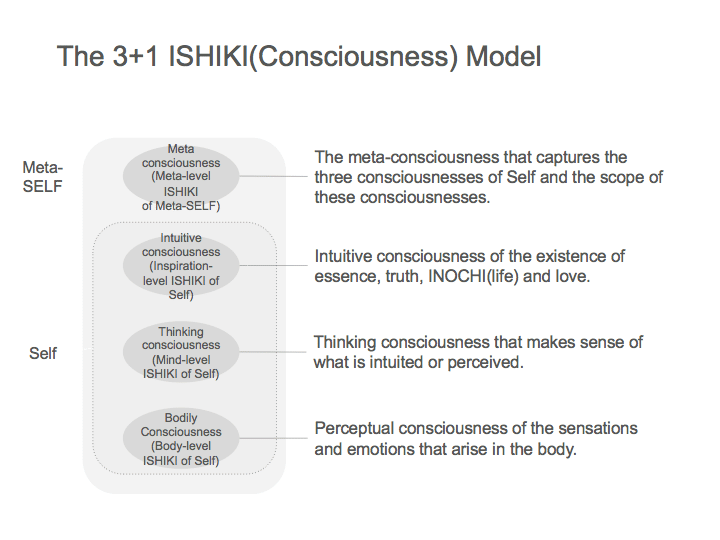
This is the 3+1 ISHIKI(consciousness) Model, in which there are two selves, the self and the meta-self. And it is composed of the three consciousnesses of intuition consciousness, thinking consciousness and bodily consciousness, which belong to the self, and the meta consciousness, which belongs to the meta-self.
What good can come from making the 3+1 ISHIKI(Consciousness) Model conscious?
The essence of the 3+1 ISHIKI(Consciousness) Model cannot be expressed in one article alone, so I will be explaining it at a time in the future, but in this article I will focus on three points.
The first is that by capturing the 3+1 ISHIKI(consciousness) Model, it is easier to prevent a bias towards a particular consciousness and feel your whole self. Today's working people are easily biased towards thinking consciousness. The thinking consciousness is adept at sharing information with others because it can handle language. In the business world, it is not surprising that the thinking consciousness is especially important because of the importance of accountability and share-ability.
However, too much of a bias toward thinking consciousness can lead us to ignore messages from our intuition and neglect our bodily consciousness (unpleasant emotions and physical discomfort), which can lead to our inability to maintain a healthy state of being as ourselves.
Secondly, having a sense of meta-consciousness makes it easier to deal with conflicts and difficulties. In a film metaphor, if the actor in the film is the self, then the film director is the meta-self. Meta consciousness is precisely the perspective of this film director.
I myself suffered a downturn in business performance in the early stage of the pandemic in 2020. I can now regard this circumstance as the greatest opportunity to promote the digital transformation (DX) of my company's business, but March/April 2020 was a very difficult time for me mentally.
It was during those times that my pain was eased a little bit by being aware of myself as a film director, watching myself suffer as an actor. I was able to say to myself, "This scene is important to the overall story of the film, so let's play the role of the painful self."
In this way, when you have a meta consciousness, you have the sense that you are watching your film from the director's point of view, it becomes easier to deal with conflicts and difficulties.
Third, the 3+1 ISHIKI(Consciousness) Model is something that is accessible and can be practiced at any time in the internal senses. There are many frameworks and theories that are useful for management, but many of them deal with phenomenal events and are often not replicable to the individual's internal senses.
If we divide things broadly by cause and effect, the frameworks and theories often deal with the "effect-side" of cause and effect, so it may not be clear to you about "So what do I do?". (I describe this as being "integral" in mathematical sense.)
The 3+1 ISHIKI(Consciousness) Model, on the other hand, deals with the "cause-side" of cause and effect. This is because, as I explained earlier, consciousness creates action and action creates phenomena. And as I mentioned earlier, consciousness is something that can be felt in the body sensory sense and is something that is close to us that we can practice at any time. (I describe this as being "differential" in mathematical sense.)
We have talked about what the 3+1 ISHIKI(Consciousness) Model is and what its benefits are.
While this talk itself is understandable, some of you may have the impression that we are talking about something quite distant when you return to the initial perspective of "management".
The Whole Picture of Management that Integrates Contradictions
The 3+1 ISHIKI(Consciousness) Model is the most essential in the sense that it is both a paradigm for integrating contradictions in management and a form that can be practiced by anyone at any time.
On the other hand, because it is essential, it is also difficult to connect with the big picture from a "management" perspective.
If the 3+1 ISHIKI(consciousness) Model is a micro and differential representation of the "paradigm for integrating contradictions in management", our team has been exploring what the macro and integral representations of that paradigm are that represent the whole picture.
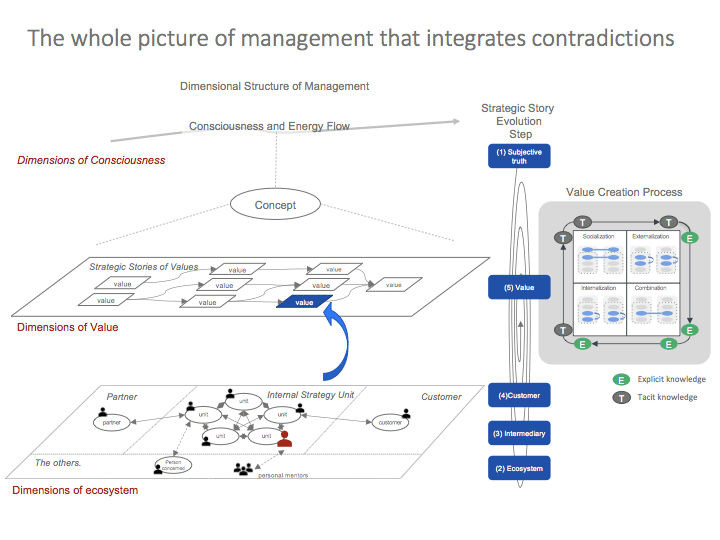
This is the overall macroscopic, integral picture of the paradigm for integrating contradictions in management.
It would be difficult in terms of the volume of articles to explain all of the details of this big picture here, so I will leave it for a future article, but I will limit myself to discussing three features and benefits here.
The first feature is that it encompasses all of the contradictions in self management, business management and people management that I mentioned at the beginning of this article. The contradictions of self and people management are expressed in the dimension of the ecosystem, and the contradictions of business management are expressed in the dimension of value. It also encompasses not only the contradictions within the respective domains of management, but also the contradictions between self and people management and between people and business management.
Thus, by embracing contradictions and conflicts within the whole picture, it becomes easier to have a new idea "C", a new worldview of Aufheben that encompasses both "A and B", rather than a worldview of conflict, "either A or B."
The second feature is that it connects the macro-integral whole picture with the micro-differential sense of the self. As you will notice that the 3+1 ISHIKI(Consciousness) Model is described on the right side of this figure, it encompasses the "ISHIKI(consciousness) Management" which is the root of creating this whole picture.
This allows you to connect and capture what internal sensations of yourself have an impact on your overall management. Simply put, you can intuitively and bodily sense the connection between your consciousness and the company's sales and profits.
Unfortunately, if you see this whole picture as a goal to be achieved while you don't have a connection with your own consciousness, it won't work. This is because the sense of "twisting what isn't there" depletes the energy for realization. On the other hand, if you have this whole picture as a worldview, as a target for the energy that comes from within you, it will work.
The third feature is that this big picture encompasses the management frameworks and theories that are commonly used in the area of management and consulting. Those who are familiar with management frameworks and theories may have noticed that this big picture includes the following theories.
▼ The SECI process... "The Knowledge-Creating Company (Ikujiro Nonaka and Hirotaka Takeuchi)
▼ Competitive strategy as a narrative story..."Competitive Strategy as a Narrative Story (Ken Kusunoki)"
▼ The Innovator's Dilemma / Ambidextrous Organization... (Clayton M. Christensen, Charles A. O’Reilly, Michael L. Tushman)
▼ Dual Process Theory ... "Fast and Slow" (Daniel Kahneman)
In addition to the above, it encompasses the integrated ideas of Porter's Structure Conduct Performance Theory (SCP Theory) and Barney's Resource Based View (RBV), as well as more recent ideas that have been emphasized in the context of innovation, such as design thinking and art thinking.
The model and overall picture proposed in this article is not a rejection of existing management theories. Rather, we believe that they are compatible and complementary to each other.
The reason why we believe it is important to be compatible with these management theories is that by connecting the concepts and language with objectively validated management theories, we are able to test the validity of these concepts and models.
At this point in time, the 3+1 ISHIKI(Consciousness) Model and the whole picture of management that integrates contradictions are not academically validated, they are just hypotheses. However, we hope to create an environment for this model to evolve by making conceptual connections with validated management theories to ensure its future validation.
In this article, I have introduced that the paradigm for integrating contradictions in management is the "ISHIKI(Consciousness) Management" as a concept and the micro and differential "3+1 ISHIKI(Consciousness) Model" and the macro and integral "Whole Picture of Management that Integrates Contradictions" as specific models for this concept.
For those of you who found this article interesting, useful, and would like to use it, I will share this worldview in more detail in future articles, so stay tuned!
Thank you very much for reading this long article.
Bunshiro Ochiai
この記事が気に入ったらサポートをしてみませんか?
